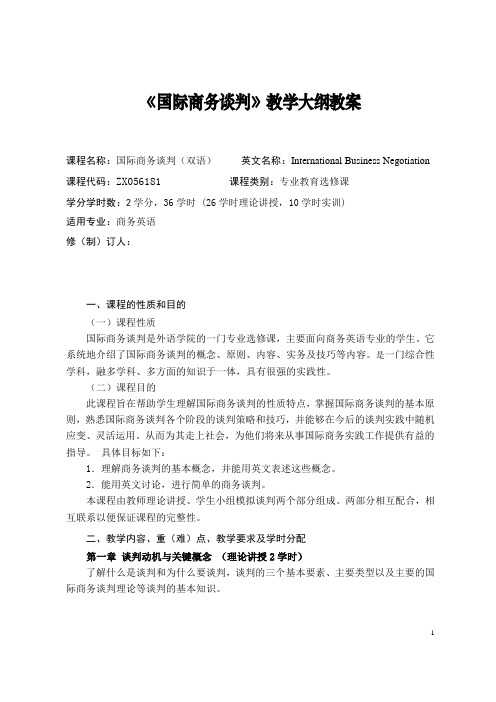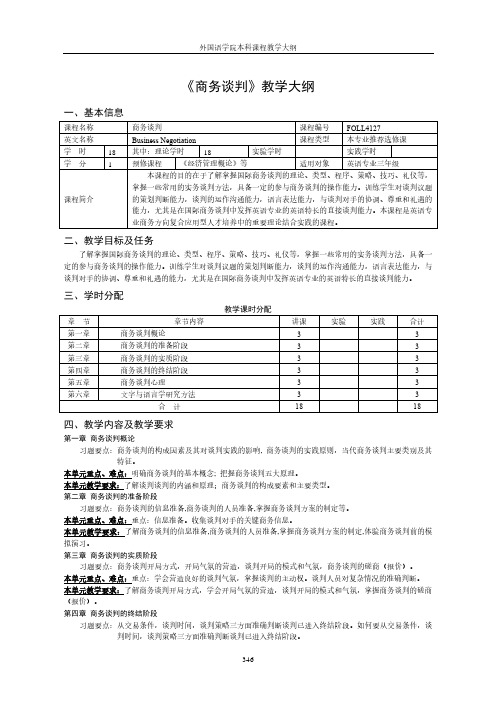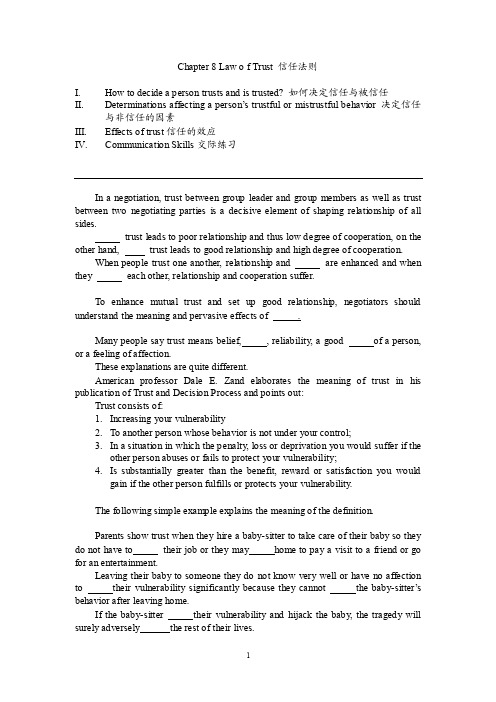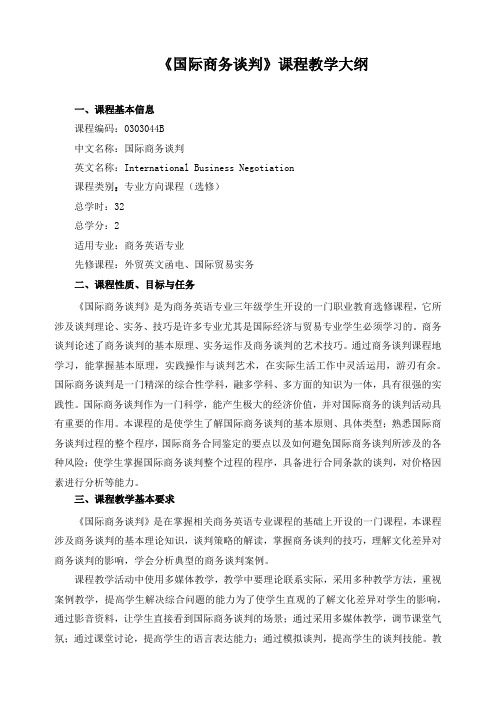国际商务谈判(双语)181--国际商务谈判教学大纲
国际商务谈判英文版最新版教学课件第2章

• Self-assessment • Assessment of the counterparty • Assessment of the situation
批注本地保存成功开通会员云端永久保存去开通
2-1
Part One The Essentials of Negotiation
— Chapter 2 — Preparation:
What to Do Before Negotiation
2-2
The Fixed-Pie Perception
Most negotiators believe whatever is good for one party must be bad for the counterparty.
People with this fixed-pie perception take one of three mindsets when preparing for a negotiation:
• Resign themselves to capitulating to the counterparty
2-11
Self-Assessment: Endowment Effects
Differences in negotiators’ reference points may lead buyers and sellers to have different valuations for the same object
• Brainstorm your alternatives. • Evaluate and order each alternative’s value. • Attempt to improve your BATNA. • Determine your reservation price based on facts. • See Exhibit 2-1.
商务英语谈判课程(标准)大纲、实训、指导书

《商务英语谈判》课程标准课程名称:《商务英语谈判》课号: 216217所属系部:外语系适用专业:商务英语课程类型:B类1、前言1.1课程性质与任务本课程是商务英语专业必修课程,也是商务英语专业的核心课程之一。
该课程是主要培养学生如何利用电话、面对面等口头形式,针对国际贸易业务过程中的建立业务关系、市场调研、询盘、报盘、还盘、接受等一系列环节,进行业务往来的磋商与洽谈。
它是一门涉及国际贸易实务,商务英语口语、商务谈判技巧等广阔领域的综合学科,它具有很强的实践性。
本课程的教学任务主要是为了培养和提高学生的外贸业务磋商能力、英语口头表达能力和与人沟通的能力,为学生今后在外贸岗位上顺利进行外贸业务的洽谈打下坚实的实践基础。
1.2设计思路本课程标准以就业岗位需求为导向,通过对外贸岗位进行任务和职业能力分析,并以工作任务导向引领确定本课程的结构,以职业能力为基础确定本课程的内容。
具体教学实施中,通过把本课程所要求掌握的外贸环节中各项外贸工作任务进行分解设计,从而实施项目化实践教学,使学生在认识商务英语谈判基础知识的基础上,能够灵活地进行外贸业务的磋商。
课程教学内容以“理论适度,形式多样,注重实践”,突出商务英语谈判知识的应用和实践能力的培养,基础理论教学以应用为目的,以必需、够用为度。
本课程教学总学时36学时。
2、课程培养目标通过对学生进行全面的、严格的实践训练,使学生具有较系统的商务英语谈判的基础知识,提高在外贸活动各个环节中应用英语的能力与英语口头交际的能力,从而能够胜任涉外贸易业务工作。
本课程的开设,目标是使商务英语专业学生对国际商务谈判的发生原理、商务谈判的原则和程序、商务谈判的准备工作、商务谈判计划的制定、谈判策略与技巧的使用、商务谈判的内容等有一个较全面的了解,并通过案例教学和实际训练,使学生具备一定的谈判能力。
通过本课程教学,培养学生具有一定的职业意识与职业能力。
通过本课程多种形式的教学手段和教学方法,使学生具体达到以下目标:·在知识方面:使学生能将商务英语谈判的基本理论和系统知识运用到外贸活动实践中,能胜任外贸业务对外交流的要求;·在素质方面:提高学生跨文化交际能力、培育学生热爱对外贸易的热情,提高为国创汇的业务水平;·在能力方面:通过本课程的学习,使学生具有以下职业能力:①商务英语谈判能力;②商务沟通能力;③商务英语阅读与分析能力。
国际商务谈判内容

问题:如何看美方的论述?中方外贸代理面对美方论述该怎么回答?
分析:美方论述以现象代替本质,用中方表面行为代替美方需要执行合同的效果。但中方调 设备的确有一定的风险,按合同规定会有问题,如果中方没把握,绝对不能轻率行事。中方 此次行为主要是当时判断此事有把握,通过“等与行”的对比后决定的行为,从本质意义上 说对中美双方都有积极效果。中方代理回答时应先从概念人手,依据合同谁有过进行分析, 再依过推算谁损失最大,相信通过沟通最终美方会感谢中方为其减少负担.井能继续履行未 完的合同义务。
三、货物买卖谈判中的价格条款
一、价格条款的基本内容 1、单价。商品单价通常由计量单位、单位价格金 额、计价货币和贸易术语4部分组成。 2、总值,亦称总价,即一笔交易的贷款总金额。
二、订立几个条款应注意的问题 1、贸易术语的选择 2、计价货币的选择
第二节 品 质
一、品质概述
二、国际商务谈判中对商品品质的特殊要求 1、国际贸易商品要适应各国销售市场的消费习惯和消费水平。 2、国际贸易商品要适应各国销售市场的季节和其他自然条件。 3、世界各国在长期的发展过程中形成了不同的宗教与文化特点 ,这是国际交往中必须尊重的。 4、国际贸易商品要遵守进口国政府与有关法律和条例的规定。
但玻璃熔炉还需要维护保温。西方人回家过节是法定的,可中方生产线停顿是有代价的,两 者难以融合。 美国专家走后,中方专家决定自己解决问题,经过中方专家一周的奋战,终于将问题最大 的、全线配合最关键成型机调试好了,只要成型机能生产合格的玻壳,其它设备就能按其节 奏正常运转。 三周后美国专家回到工厂看到仓库生产的合格玻壳,十分惊讶问“怎么回事?”厂方告诉他已 调通生产线后,专家大怒说:“按照合同没调好设备中方不能动,否则要对此负责。”随后 又向佳华厂的外贸代理公司作出严正交涉:“对工厂的生产设备以后将不承担责任,如果影 响贷款回收要进行索赔。”
国际商务谈判课程教学大纲

《国际商务谈判》课程教学大纲制订人:戴宗群教研室主任:戴宗群主任日期:2006年6月第一部分大纲说明【1】课程编号:【2】课程性质:专业课【3】适用专业:国际贸易实务【4】先修课程:《进出口实务(一)》【5】后续课程:《国际市场营销》【6】总学时:56学时【7】总学分:3学分第二部分教学目的与要求【1】课程性质、目的与要求:《国际商务谈判》课程是一门专业必修课程,是一门理论和实践密切结合的应用性学科,主要介绍商务谈判的有关知识、技巧和方法,具有知识面广、法律性强、实践性强、系统性强的特点,是国际贸易实务专业的一门必修课。
通过本课的学习,要求学生掌握有关商务谈判内容和方法的基本知识,懂得商务谈判的有关法律规定,基本掌握商务谈判的程序及技巧,掌握商务谈判的策略及有关技能,平衡处理谈判过程中遇到的错综复杂的风险、策略、利益关系,为今后从事商务谈判工作打下良好的基础。
【2】学时分配表:本课程为考查课,共56学时,3学分,具体学时分配如下表所示:【3】考核方法:本课程为考查,成绩由两部分组成:1、平时成绩:依据平时作业、课堂表现及纪律情况打分,占20%2、期末考试成绩:采取闭卷笔试、面试等方式,占80%第三部分教学内容第一章导论206级教学大纲 江海职业技术学院经贸系国际商务谈判3 本章主要涉及谈判的定义、动因、要素、类型等。
要求掌握谈判的定义、谈判的一般动因,即谈判的目的性、谈判的相互性、谈判的协商性;熟悉谈判的基本要素:谈判当事人、谈判议题、谈判背景,三者缺一就不能谈判;了解谈判客观上存在各种不同的类型,认识这些不同的类型,目的在于根据其不同特征和要求采取有效的谈判策略。
内容主要包括: 1、教学内容第一节 谈判的定义和动因 一、谈判的定义 二、谈判的动因第二节 谈判的要素和类型 一、谈判的基本要素 二、谈判的主要类型 2、教学要求(1)重点掌握谈判的基本要素和主要类型第二章 商务谈判概述本章是对商务谈判的概述,全面介绍商务谈判的概念、特征与职能,程序与模式,原则与成败标准等。
国际商务谈判教学大纲教案2

《国际商务谈判》教学大纲教案课程名称:国际商务谈判(双语)英文名称:International Business Negotiation 课程代码:ZX056181 课程类别:专业教育选修课学分学时数:2学分,36学时 (26学时理论讲授,10学时实训)适用专业:商务英语修(制)订人:一、课程的性质和目的(一)课程性质国际商务谈判是外语学院的一门专业选修课,主要面向商务英语专业的学生。
它系统地介绍了国际商务谈判的概念、原则、内容、实务及技巧等内容。
是一门综合性学科,融多学科、多方面的知识于一体,具有很强的实践性。
(二)课程目的此课程旨在帮助学生理解国际商务谈判的性质特点,掌握国际商务谈判的基本原则,熟悉国际商务谈判各个阶段的谈判策略和技巧,并能够在今后的谈判实践中随机应变、灵活运用。
从而为其走上社会,为他们将来从事国际商务实践工作提供有益的指导。
具体目标如下:1.理解商务谈判的基本概念,并能用英文表述这些概念。
2.能用英文讨论,进行简单的商务谈判。
本课程由教师理论讲授、学生小组模拟谈判两个部分组成。
两部分相互配合,相互联系以便保证课程的完整性。
二、教学内容、重(难)点、教学要求及学时分配第一章谈判动机与关键概念(理论讲授2学时)了解什么是谈判和为什么要谈判,谈判的三个基本要素、主要类型以及主要的国际商务谈判理论等谈判的基本知识。
1讲授内容:一、谈判二、冲突三、利益得失案例研究克莱斯勒公司错失进入中国汽车市场良机重点:谈判的三个基本要素:谈判、冲突、利益难点:冲突第二章谈判程序与结构(理论讲授1学时,模拟谈判1学时)了解商务谈判的基本知识,熟悉商务谈判的一般程序,能分析影响商务谈判模式的基本因素,掌握商务谈判的基本结构。
讲授内容:一、谈判程序二、谈判的一般结构三、贸易谈判结构模拟谈判一次经济衰退案例研究Ⅰ对等性让步原则案例研究Ⅱ中关知识产权谈判重点:谈判一般程序及询盘、发盘、还盘、接受难点:谈判一般程序第三章谈判润滑剂(理论讲授2学时)理解商务谈判的准备工作对谈判进程和谈判结果的重要影响,掌握各项准备工作的原则、范围和方法。
《国际商务谈判》教学大纲

《国际商务谈判》授课大纲一、课程的性质、目的与任务课程性质:本课程属于国际贸易专业的专业课。
课程任务:一、理论部分。
交融国内外经典的谈判理论,主要涉及国际商务谈判的基本见解、国际商务谈判人员的组织与管理、谈判前的准备、谈判中的策略与技巧、各大洲文化差别对谈判的影响等内容,运用模型和实例解析对影响谈判全过程的主要要素进行了比较全面的解析。
二、事例研究。
结合理论部分的讲解,进行相应的事例解析,除了使用经典的谈判事例,更加侧重收集并解析涉及现在热点问题的事例。
三、模拟谈判。
模拟谈判的目的是使学生经过实质操练领悟谈判理论的指导意义,获取比较凑近实质的真实体验。
经过亲身实践获取的经验教训对他们来说更加生动、详尽。
除模拟谈判外,每章结束后都会给出相应的思虑与谈论题。
二、授课目的此课程旨在帮助学生理解国际商务谈判的性质特色,掌握国际商务谈判的基本源则,熟悉国际商务谈判各个阶段的谈判策略和技巧,并能够在今后的谈判实践中见机而作、灵便运用。
从而为其走上社会,为他们将来从事国际商务实践工作供应有益的指导。
三、主要授课内容及要求第一章谈判发生的原理【目的和要求】1.掌握什么是谈判和为什么要谈判。
2.熟悉谈判的三个基本要素、主要种类3.认识主要的国际商务谈判理论等谈判的基本知识。
【主要内容】讲解内容第一节谈判归纳一、谈判是解决矛盾矛盾的手段在我们生活的世界里,存在着各样各样的矛盾矛盾。
惹起这些矛盾矛盾的原因有经济的、政治的、外交的、宗教的和文化的,等等,其中由经济原因惹起的矛盾是最根本和最宽泛的。
人类在解决矛盾矛盾时所使用的方法基本上可归纳为两大类:军事手段与和平手段,而和平手段即是谈判。
1.资源的稀缺性:资源的稀缺性指在我们生活的地球上,人类赖以生计的自然资源是有限的、不能再生的。
资源的稀缺性还有对于人类对物质财富的无量占有欲望而言。
二、谈判是一种宽泛的生活现实事实上谈判已被人类应用于生活中大大小小的各样事务和场合中,谈判是一种生活现实。
《商务谈判》教学大纲

《商务谈判》教学大纲一、基本信息二、教学目标及任务了解掌握国际商务谈判的理论、类型、程序、策略、技巧、礼仪等,掌握一些常用的实务谈判方法,具备一定的参与商务谈判的操作能力。
训练学生对谈判议题的策划判断能力,谈判的运作沟通能力,语言表达能力,与谈判对手的协调、尊重和礼遇的能力,尤其是在国际商务谈判中发挥英语专业的英语特长的直接谈判能力。
三、学时分配四、教学内容及教学要求第一章商务谈判概论习题要点:商务谈判的构成因素及其对谈判实践的影响, 商务谈判的实践原则,当代商务谈判主要类别及其特征。
本单元重点、难点:明确商务谈判的基本概念; 把握商务谈判五大原理。
本单元教学要求:了解谈判谈判的内涵和原理;商务谈判的构成要素和主要类型。
第二章商务谈判的准备阶段习题要点:商务谈判的信息准备,商务谈判的人员准备,掌握商务谈判方案的制定等。
本单元重点、难点:重点:信息准备。
收集谈判对手的关键商务信息。
本单元教学要求:了解商务谈判的信息准备,商务谈判的人员准备,掌握商务谈判方案的制定,体验商务谈判前的模拟演习。
第三章商务谈判的实质阶段习题要点:商务谈判开局方式,开局气氛的营造,谈判开局的模式和气氛,商务谈判的磋商(报价)。
本单元重点、难点:重点:学会营造良好的谈判气氛,掌握谈判的主动权。
谈判人员对复杂情况的准确判断。
本单元教学要求:了解商务谈判开局方式,学会开局气氛的营造,谈判开局的模式和气氛,掌握商务谈判的磋商(报价)。
第四章商务谈判的终结阶段习题要点:从交易条件,谈判时间,谈判策略三方面准确判断谈判已进入终结阶段。
如何要从交易条件,谈判时间,谈判策略三方面准确判断谈判已进入终结阶段。
本单元重点、难点:从交易条件,谈判时间,谈判策略三方面准确判断谈判已进入终结阶段。
如何要从交易条件,谈判时间,谈判策略三方面准确判断谈判已进入终结阶段。
本单元教学要求:了解商务谈判终结的判断包括从谈判涉及的交易条件判定、从谈判时间判定、、从谈判策略判定,掌握商务谈判终结的方式包括谈判终结的原则和谈判终结的方式。
国际商务谈判第二章 国际商务谈判理论

AMT咨询公司服装高级咨询师葛星表示,僵持局面恰好反映了目前 国内体育用品行业渠道商与品牌商在谈判桌上的地位角色有了一定的转 变。耐克、阿迪达斯这两大超级巨头在进入中国市场之初通过对代理商 的操控,促使他们之间相互竞争而快速扩张。而现如今,百丽通过香港 上市募得丰厚现金,在国内市场上又大肆收购整合渠道,坐上了国内鞋 业渠道第一把交椅。宝元凭借背后的台湾宝成集团也在极力扩张。加上 由深圳龙浩、沈阳鹏达、四川劲浪等区域经销商组团,国内渠道一时三 分天下。“前几年是阿迪、耐克强势,现在是百丽等渠道商的议价能力 在谈判中占主导——如果渠道因共同的利益诉求而联合起来的话。”
34
• 2008年阿迪达斯成为了北京奥运会的赞助商。2009年4月前,所 有印有北京2008奥运会标志的商品都已宣布过期。在此之前,很 多经销商都过高的估计了奥运行情,在奥运前大肆拿货。然而, 奥运会并没有为体育用品行业带来经销商预期的爆发行情,导 致经销商的库存严重,很多经销商的库存都消化不掉。 有知情 人士称,百丽等几家大型体育用品经销商,与阿迪达斯坐到了 谈判桌前。经销商希望通过打折销售库存产品等方式尽快摆脱 库存压力。但阿迪达斯从品牌价格稳定的角度着眼,并不认可 经销商的采取上述行为降低库存。就这样,阿迪达斯与渠道经 销商的矛盾升级。
18
第三节 博弈论与商务谈判
19
第三节 博弈论与商务谈判 一、博弈论的基本概念
博弈论是应用经济学的一个分支,也是经济学的重要分析 工具之一。1944年,冯·纽曼和摩根斯坦正式提出将其作为一门 独立的学科。
20
第三节 博弈论与商务谈判 二、囚徒困境对商务谈判的启示
商务谈判中遇到的交易分为四种类型。
第二节 理性谈判
30
第二节 理性谈判
国际商务谈判(英文)教案讲义Chapter8LawofTrust信任法则

Chapter 8 Law o f Trust 信任法则I.How to decide a person trusts and is trusted? 如何决定信任与被信任II.Determinations affecting a person’s trustful or mistrustful behavior 决定信任与非信任的因素III.Effects of trust信任的效应munication Skills交际练习In a negotiation, trust between group leader and group members as well as trust between two negotiating parties is a decisive element of shaping relationship of all sides.trust leads to poor relationship and thus low degree of cooperation, on the other hand, trust leads to good relationship and high degree of cooperation.When people trust one another, relationship and are enhanced and when they each other, relationship and cooperation suffer.To enhance mutual trust and set up good relationship, negotiators should understand the meaning and pervasive effects of .Many people say trust means belief, , reliability, a good of a person, or a feeling of affection.These explanations are quite different.American professor Dale E. Zand elaborates the meaning of trust in his publication of Trust and Decision Process and points out:Trust consists of:1.Increasing your vulnerability2.To another person whose behavior is not under your control;3.In a situation in which the penalty, loss or deprivation you would suffer if theother person abuses or fails to protect your vulnerability;4.Is substantially greater than the benefit, reward or satisfaction you wouldgain if the other person fulfills or protects your vulnerability.The following simple example explains the meaning of the definition.Parents show trust when they hire a baby-sitter to take care of their baby so they do not have to their job or they may home to pay a visit to a friend or go for an entertainment.Leaving their baby to someone they do not know very well or have no affection to their vulnerability significantly because they cannot the baby-sitter’s behavior after leaving home.If the baby-sitter their vulnerability and hijack the baby, the tragedy will surely adversely the rest of their lives.But if the baby-sitter their vulnerability and take good care of the baby, then the parents can keep their mind on their work or enjoy their meeting with their friend or a party.There are three fundamental elements: information, influence and control.A person shows trust when he reveals he need not disclose.He increases his by telling others his goals, purpose, plans, alternatives or his problems.Others may make use of the information to impede or undermine his efforts.For example,A designer struck on a brilliant idea which he told a colleague working in the same office. The colleague used the idea to advance his own interests and was promoted soon.So a person who does not others will conceal or distort relevant information.He will facts, his purpose and his feelings.A person show trust when he shows others to his decisions since he increases his by asking for others’ advice which may deliberately him.For example,As a China’s famous story of Fighting in Chibi in Tale of Three States depicts Caocao (premier of East Han Dynasty) asked for Pangtong’s (a counselor secretly working for Dongwu, Caocao’s enemy) advice for defeating Dongwu. Pangtong offered him a seemingly clever advice, which turned out to be a part of fatal plot inducing him and his troops into a trap.Therefore, a person who shows will resist others’influence, deny and reject their suggestions and advice.A person shows when he delegates and permits others to act on their own on his behalf.By this way he increases his because he has to rely on others to make a judgment and to implement his plan and others may serious errors, ____ implementation and his plan.So if a person does not trust, he will try to impose over others and ____ his dependence on others.For example,The principal of a middle school had peep holes installed in all the doors of classrooms in order for the administrative to have a tighter over students.However the device produced skeptical atmosphere among staff members as wellbecause anyone teaching or staying in the classroom feels he is being watched over and he is not .In negotiation or in people’s daily life, elements affecting a person’s trustful or mistrustful behavior come form main sources: which is inalterable and grown-up experiences, which are changeable.Childhood educationStudies on childhood education on trust began in the 1950s, with the publication of Erik Erikon’s Childhood and Society. Since then many developmental psychologists have viewed trust and; mistrust as the cornerstones of human development.A child’s understanding of trust is from his own and the environment he is up.When a child’s desires and reliability are fulfilled in most cases, he tends to conclude that people are , otherwise, he may draw the from his unfulfillment that people are trustful.A child will tend to trust others if he is brought up in a simple, warm and _____ environment, and he is told the stories of help and trust.However in other context, a child’s parents and other people intentionally inform him of examples of mistrust to drive the that “Y ou can’t trust people”.Understandably, such child inclines not to others when he grows up.Professional or special trainingA person’s professional or special training can incline him a different orientation to .For instance, accountants and financial workers are oriented to be of financial statements full of identical numbers and how much they may differ from the real data.People working in human resources department appear to more the accuracy of a person’s description of his educational and working background, and it is an important reason that the application documents should be, at the request, _____by official certificates.Past credit recordA person’s willingness to trust another person on his knowledge of the other’s past record.We will not rust someone who to perform his duty or is to complete a task or fails to keep his .The reason for the failure may differ from time to time, however, if there isrepeated record of the person’s failure, is the natural results.Surely, a person can do better to improve his record and thus win others’trust.Competence of others to perform a taskA person’s willingness to trust another person depends on his estimation of the other’s ability to complete a task .At this point, there should be a distinction between capability and affection.For instance, you will not trust a teenager to send a large sum of money to a far away place although you him very much.When is confused with capability in one’s trust decision, more often than ____his plan will be undermined.Intentions of othersOur willingness to trust another person is determined by our interpretation of the other’s intentions. i.e. We will not trust those we believe who have intention, and who will exploit our resources and take of our trust to advance his own interests.We will not trust such kind of person even though he is and he has a good _____record.People’s interpretation of others’intentions and motives can be different from time to time depending on their understanding of others.Reward systemIn win-lose reward system, when competition is rewarded, i.e., our gain is the other’s loss and our loss is the other’s gain, trust the other is clearly not in our self-interest.Companies selling the same products are rivals in business and understandably they will conceal or information, withhold facts and their ideas.Things will be different in joint reward system in which is encouraged because in such reward system things won’t be done without joint efforts, so it is all natural that the two sides will each other, information, each other’s advice and reach common conclusion.Of course, in today’s world there are neither competitors nor cooperators. Where will things be directed depends on our efforts. It is hoped that trustful relationship among people should be on account of positive effects of trust.Trust is a decisive element in people’s relationship. We need trust between peers, superiors and , between producers and , teachers and .Studies show that trust intellectual development and originality, and leadsto emotional stability and self-control.Trust acceptance and openness of expression.Trust cooperation and mutual understanding, and it is fundamental for establishing sound relationship among negotiating team as well as between negotiating .People working in a team high in trust signal of trust to each other and _____trust form each other, which will increase level of trust among the members. Negotiations based on high level of trust can increase of double win results.Conversely, mistrust rejection and defensiveness, collaboration and relationship of team members and negotiating parties.The striking contrast of trust and mistrust between negotiating parties tells us that it is worthwhile we take great pains to find out ways to mutual trust.Some tentative suggestions are made here for consideration:1.Encourage mutual trust by establishing trust-rewarded system in_____education, in training and in .2.Buildup people’s confidence in trust bit by bit through giving ,influence, self-control and concessions, and seek reciprocation from theother.3.Discuss frankly with the other party what is generating innegotiation.4.Be sincere and honest to your negotiating team members andyour .1. What comment would you make in the following situations?1)Y ou’ve just heard news of a train crash.2)One of your colleagues is always chatting to everybody.3)One of your colleagues regularly works a twelve-hour day.4)Y ou’ve just had a very good meal.5)One of your colleagues keeps himself to himself.6)Y ou’ve just seen an exhibition you expected to be good; in fact it was not.7) A person you’ve just met says he is a film director.8)One of your colleagues looks very smart today.2. Answer the following questions1)How many means are needed for the sellers to inform the buyers of the quality? What are they?2)When selling some mechanical and electrical products, what means are generally used to express their quality?3)When negotiating on the packing, what aspect should the buyers pay attention to besides the right type of packing?4)When goods are sold on a CIF basis, who is under obligation to present a marine insurance policy or an insurance certificate at the time of negotiation, the seller or the buyer?5)Which method is safer and better for the seller, D/P or D/A?6)Why is commodity inspection indispensable in international trade?7)What’s the first step in a successful sales negotiation?8)Is it necessary for the seller to make an equal concession when the buyer grants him or her a concession?9)At the beginning of the negotiation, should the sellers open high or modest?10)When you meet with negotiators who harshly bargain with you, will you cancel the negotiation or continue?11) If a negotiator s ays: “I don’t have the authority to grant you that concession”, does it really mean that he or she hasn’t such authority or is it only negotiating tactics?5. Translate the following situational dialogue into English(交货Delivery)贺先生,我很高兴我们就价格和付款方式问题达成了协议。
《国际商务谈判》课程教学大纲

《国际商务谈判》课程教学大纲一、课程基本信息课程编码:0303044B中文名称:国际商务谈判英文名称:International Business Negotiation课程类别:专业方向课程(选修)总学时:32总学分:2适用专业:商务英语专业先修课程:外贸英文函电、国际贸易实务二、课程性质、目标与任务《国际商务谈判》是为商务英语专业三年级学生开设的一门职业教育选修课程,它所涉及谈判理论、实务、技巧是许多专业尤其是国际经济与贸易专业学生必须学习的。
商务谈判论述了商务谈判的基本原理、实务运作及商务谈判的艺术技巧。
通过商务谈判课程地学习,能掌握基本原理,实践操作与谈判艺术,在实际生活工作中灵活运用,游刃有余。
国际商务谈判是一门精深的综合性学科,融多学科、多方面的知识为一体,具有很强的实践性。
国际商务谈判作为一门科学,能产生极大的经济价值,并对国际商务的谈判活动具有重要的作用。
本课程的是使学生了解国际商务谈判的基本原则、具体类型;熟悉国际商务谈判过程的整个程序,国际商务合同鉴定的要点以及如何避免国际商务谈判所涉及的各种风险;使学生掌握国际商务谈判整个过程的程序,具备进行合同条款的谈判,对价格因素进行分析等能力。
三、课程教学基本要求《国际商务谈判》是在掌握相关商务英语专业课程的基础上开设的一门课程,本课程涉及商务谈判的基本理论知识,谈判策略的解读,掌握商务谈判的技巧,理解文化差异对商务谈判的影响,学会分析典型的商务谈判案例。
课程教学活动中使用多媒体教学,教学中要理论联系实际,采用多种教学方法,重视案例教学,提高学生解决综合问题的能力为了使学生直观的了解文化差异对学生的影响,通过影音资料,让学生直接看到国际商务谈判的场景;通过采用多媒体教学,调节课堂气氛;通过课堂讨论,提高学生的语言表达能力;通过模拟谈判,提高学生的谈判技能。
教学中,通过课堂讨论、案例分析提高学生语言表达能力的培养,采取灵活多边的教学方法和模式,增加讨论分析课时。
国际商务谈判课程教学大纲

《国际商务谈判课程》教学大纲课程名称:国际商务谈判课程编号: 11153002 英文课程名称:International Business Negotiations适用专业:国贸,金融,经济总学时数:30 学分数:2理论教学时数:10 实验(实践)教学时数:20 执笔人:黄伟编写日期:2017年2月一、课程性质与任务《国际商务谈判》是国际经济与贸易专业的专业基础课程,融多学科、多方面的知识于一体,具有很强的实践性、操作性的课程。
该门课程的主要教学任务是以人才培养与社会需求相适应为核心,强化理论与实践相结合,通过本课程理论和试验课程学习,使学生掌握并运用国际商务谈判策略、技巧、跨文化沟通能力,以实现以“知识、能力、素质”交融培养和“厚基础、强特色、重创新”为课程培养目标。
二、课程教学目标1.通过本课程的学习,了解国内外经典的谈判理论,包括谈判产生的原因、谈判结构、双赢理念、合作原则谈判法、谈判力、利益分配法则、信任法则、博弈论在谈判中的应用、两分法谈判与复杂谈判、谈判个人心里和文化背景等,能运用基本理论和实例对影响谈判全过程的主要因素进行全面分析。
2.结合理论部分内容进行具有典型性和普遍性的案例分析,使其更好地服务于理论的讲解,培养学生认识问题、分析问题和解决问题的能力。
3.通过网络谈判教学让学生运用先进教学设备和技术手段,及时查找就商务谈判相关前沿发展现状和趋势,了解贸易谈判中的相关新政策等信息。
4.学生在模拟谈判整个过程中(谈判前、谈判中和谈判后)可以依据真实案例比较实际谈判的结果和自己谈判的结果,获得比较接近实际的真实体验,培养学生具有良好的品德修养、较强的语言表达能力、沟通能力、熟练运用外语进行跨文化交流能力,具有综合不同学科知识解决实际问题的能力、独立思考的能力和创新思维的能力和团队合作能力。
三、课程教学内容、要求及学时分配1.理论教学Chapter I An Overview of IBN one class hour Section I Concept and characteristics of international business negotiation Section II Principles of Business NegotiationSection III The types of international business negotiationSection IV Form & Approaches of Business CommunicationKey point: Negotiations are a struggle of wits and capabilities as well as a chase of strategy and skills. Under the circumstance of market economy, business negotiations covering everywhere and any time can contribute to a significant impact on companies’ survival and development.The corresponding course teaching objectives:1Chapter II The theories of international business negotiation one class hour Section I The Economic theorySection II The Basic Psychological Theory of Business NegotiationSection III Integrative approach and win-win principleSection IV Game theory and the principle of good faithKey point: The models with the theory of comparative advantage and the theory of reciprocal demand are widely used to ensure the price of trade. The models of the theory of trade mainly shows why international trade happens and whether the profit distribution in trade is balanced or not.Difficult point: conceptThe corresponding course teaching objectives:1Chapter III Personnel quality, psychological and the group composition of International Business one class hour Section I psychology in International business negotiationSection II Individuals’psychological activities during the international business negotiationsSection III The qualities negotiators should possessSection IV Groups composition of international business negotiationKey point: This chapter shows Maslow’s Hierarchy of Needs, pointing out 5 degrees of people’s need, extending the business negotiation theory and its different uses in business negotiations, and explains the relations between ability and negotiations, qualities and negotiations and introduces different kinds of qualities and finally analyzes the features and divisions of the negotiations groups.The corresponding course teaching objectives:1Chapter IV Differences of Culture in International Business Negotiationsone class hour Section I Cultural factors affecting the style of business negotiationsSection II Cultural differences on international business negotiationSection III The business negotiation customs and styles in the prime regionKey point: The cultural differences have different influence in business negotiation. Cultural factors in negotiation style and cultural difference will have impacts on negotiation. It deals with the way to treat cultural differences in negotiation.The corresponding course teaching objectives:1Chapter V Preparations for Business Negotiations one class hour Section I The Preparations of Business NegotiationsSection II The Information Preparation for Business NegotiationsSection III Business negotiation plansSection IV Simulated NegotiationKey point: Preparation of negotiators is to set up a team, which includes the scale of the negotiation team, the quality of negotiators which should be possessed by the negotiators and division cooperation between group members and so on. The information collection is to better understand each other’s intentions, to make proper plans and negotiation tactics, strategies and the basic premise.The corresponding course teaching objectives:1Chapter VI Business Negotiation Strategies one class hour Section I Strategies of Starting StagesSection II Strategies of offerSection III Strategy of consultation stageSections IV Strategies on the Stage of Striking a BargainingKey point: Business negotiation strategy is generic terms of approaches, measures, techniques, tactics, tools and combinations of general application to achieve a specific goal in the process of business negotiations.The corresponding course teaching objectives:1Chapter VII Communication Skills in Business Negotiations one class hourSection I Sound Language in Business NegotiationSection II The silent Language in Business NegotiationSection III Word processing in business negotiationKey point: All the languages used can fall into two categories: verbal language and non-verbal language, language, the bridge in negotiation is the primary factor to success or failure for the negotiation. So how to use appropriately the skill of language is a major concern and consideration for the negotiators.The corresponding course teaching objectives:1Chapter VIII Different Forms of Tactics in Business Negotiationone class hour Section I Negotiation skills for the superiorSection II Negotiation skills for the inferiorSection III Negotiation skills for the balancedKey point: Choice and application of business negotiation tactics mostly depends heavily on the strong or weak strength of both sides. Exerting tactics expertly and skillfully is helpful to achieve the successful negotiation and reach objectives. The focus of this chapter is talking about the often-used negotiations skills for the negotiators in different position.The corresponding course teaching objectives:1Chapter IX Risk Aversion in International Business Negotiationone class hour Section I Analysis for the Risks of International Business NegotiationsSection II How to Forecast & Control Risks in International Business Negotiation Section III Methods to Avert RisksKey point: There are a wide range of complex factors that influence the success or failure of business activities. What we should make clear in international economic cooperation is that risks are difficult to be averted in business activities, we need to find chances to increase relatively stable return as well as to decrease the rates of causing different loss in the future.The corresponding course teaching objectives:1Chapter X Etiquette for International Business Negotiation one class hourSection 1 Summary for Etiquette in International Business NegotiationSection II Basic Business EtiquetteSection III Etiquette for International Business NegotiationKey point: Etiquette is the rules of international business negotiation if the communication processes violate the etiquette, it would not only undermine the feelings of both parties, but also affect the other aspects of yourself and evaluation, even lead to breakdown of the talks. So clearing the way for the smooth progress of negotiations is very important.The corresponding course teaching objectives:12. 实验教学:Experiment 1 2 class hours Liaoxi environmental industry park investmentⅠ. Experiment Aim:1. understand the process of business negotiation, including its concept, strategy and skill, psychological warfare spyware, how to solve the problem existed to put forward new solution.2. how to break deadlock during negotiation to promote win-win result.ⅡExperiment Theory1. Win-win Concept and Traditional Concept2. How can both sides win3. How to communicate with partner and solve the problem.Ⅲ. Experiment Content1. understand the process of Negotiation2. the characteristic of international negotiationⅣ. Experiment Demand1. each student learn the negotiation process2. offer how to handle and manage the win-win concept during the negotiationⅤ. Experiment Guidance1. Explain the structure of international negotiation according to the case.2. How can both sides get win-win result. Help students review the win-win theory.Experiment 2 2 class hoursThe office delay pay compensationⅠ. Experiment Aim:1.learn how to collect necessary information and locate the target decision2.form the staff negotiation teams3.choice of negotiation venuesⅡExperiment Theory1.Collaborative Principled Negotiation2.Invent Options for Mutual GainⅢ. Experiment Content1.Putting the above theory into the case2.Focus on Interests Not PositionsⅣ. Experiment Demand1.Prepare for the detailed data and material of the partner2.realize the programme prepared for the negotiation3.find out the shortage for each side during the process of negotiationⅤ. Experiment Guidance1.students are divided into several groups with four in each group, two students aresellers and the other two are buyers.2.continue the negotiation between two sides from where it stopped.3.the two students will discuss between themselves first and make decisions on finaloffer for the deal.Experiment 3 2 class hoursNegotiation on finance leaseⅠ. Experiment Aim:1.Team cooperation to overcome obstacle or weak point during negotiation2.put the theory into to the simulation practice and get the summary from thesimulationⅡExperiment Theoryw of interest Distribution2.Needs Theory3.Application of the Needs Theory in NegotiationⅢ. Experiment ContentAnalysis the background of seller and buyer, make out the outline for this case depending on the above theory, then try to apply to the case simulation.Ⅳ. Experiment Demand1.prepare to achieve a win-win result and apply in the negotiation2.analyze the interests of both parties and find out the common interests.3.if not reach an agreement with the other party, work out an options or alternatives. Ⅴ. Experiment GuidanceOrganize a group of 4 students. study the background materials for seller and the buyer respectively then discuss the key points to realize the finance lease.Experiment 4 2 class hoursAlteration of the right of distributionⅠ. Experiment Aim:1.Learn negotiation power and related factors2.Grasp application of power tactics3.Study factors causing the changes of negotiation powerⅡExperiment Theoryw of Trust2.Suggestions of Enhancing Mutual TrustⅢ. Experiment Content1.how to decide a person trusts and is trusted?2.Effects of Trust3.Determinants affecting a person’s trustful or mistrustful behaviorⅣ. Experiment Demand1.each group should discuss the background carefully to enhance trust one another2.analysis the secondhand market of cars and establish two at least plan fornegotiationⅤ. Experiment GuidanceWhatever each think will advance his interest, each side can introduce additional facts and assert opinions that would be plausible in this situation.Experiment 5 2 class hours Dispute on contract of purchase and sale of peanutⅠ. Experiment Aim:1.Learn the key theory and its application during negotiation2.Enhance further team cooperation and its flexibility during negotiationⅡExperiment TheoryGame Theory and Negotiation applicationⅢ. Experiment Content1.Study the organization structures of each group and understand the illustration ofGreen Bank Organization.2.to summarize the common interests and differences.3.to create and discuss new options and search for objective criteria.Ⅳ. Experiment Demand1.first group of students acting as a third party in the dispute between twodepartment managers, sales and product development, will help the other twoparties work out a solution themselves.2.the third group of students will explain his reason and if possible he may givemore of his own reasons as sales representative.Ⅴ. Experiment Guidance1.Two groups will be divided in this simulation. The first group act as a third party.The second group act as department managers and as product development.2.It is important for the second party to give his options and discuss with the otherparty in order for him to reach a solution acceptable to both sides with the help of the his own party.Experiment 6 2 class hoursSuspension of claimⅠ. Experiment Aim:1.Dealing with sales enquires2. Dealing with sales orders3. Negotiating a SaleⅡExperiment Theory1.Distributive Negotiation2.Price Negotiation and Negotiation ZoneⅢ. Experiment Content1.Study the case carefully then copy and complete the invoice with informationgiven during the conversation.2.Do the series exercises given depending on the situation points through internet. Ⅳ. Experiment Demand1.With very computer skill, the students must finish the exercises within given time.2.promoting the ability of listening and written language to enhance students’written negotiation ability.Ⅴ. Experiment Guidance1.grasp written outline and letter’s skill.2.finish the tasks with written language within given time in order to promotewriting skill.Experiment 7 2 class hoursSteel trade warehouse loansⅠ. Experiment Aim:1.Learn the definition of Culture2.Culture Patterns during negotiations around the WorldⅡExperiment Theory1.Involvement of Third Parties2.Coalition, Multi-party NegotiationⅢ. Experiment Content1.Learn Hi-tech and Technical Background nowadays by internet.2.Study the influence of Cross Culture to negotiation.Ⅳ. Experiment Demand1.Learn style of different countries’ culture and its function on negotiation2.promote your own adaptability to different culture around worldⅤ. Experiment GuidanceOrganize each side of 4 students for one group, assume that you are negotiators sent by Hi-tech. Follow the negotiation style guidelines but do not exaggerate them to the point of making them unrealistic. Discuss them with your team and plan how you will follow them in your negotiation.Experiment 8 2 class hours The joint venture of waste tire processing production baseⅠ. Experiment Aim:1.Learn the rule of joint venture and related factors2.Grasp application of power tactics3.Study factors causing the changes of negotiation powerⅡExperiment Theoryw of Trust2.Suggestions of Enhancing Mutual TrustⅢ. Experiment Content1.how to decide a person trusts and is trusted?2.Effects of Trust3.Determinants affecting a person’s trustful or mistrustful behaviorⅣ. Experiment Demand1.Each group should discuss the background carefully to enhance trust one another2.Analysis the market of waste tire and establish outline at least plan for negotiationⅤ. Experiment GuidanceWhatever each think will advance his interest, each side can introduce additional facts and assert opinions that would be plausible in this situation.Experiment 9 2 class hoursExport payment settlementⅠ. Experiment Aim:1.Application for the payment under the knowledge of payment terms2.Grasp application of payment tactics3.Study factors causing the changes of negotiation powerⅡExperiment Theoryw of International Trade2.Suggestions of Enhancing Mutual TrustⅢ. Experiment Content1.adjust the contract of business trade for export payment settlement2.win-win resultⅣ. Experiment Demand1.each group should discuss the background carefully to enhance trust one another2.analysis the secondhand market of cars and establish two at least plan fornegotiationⅤ. Experiment GuidanceWhatever each think will advance his interest, each side can introduce additional facts and assert opinions that would be plausible in this situation.Experiment 10 2 class hoursRelocation compensationⅠ. Experiment Aim:1.To overcome obstacle or weak point under adjustment of location govenmentduring negotiation2.Each sides will get the satisfactory results for the compensationⅡExperiment Theoryw of real east2.Needs Theory3.Application of the Needs Theory in NegotiationⅢ. Experiment ContentAnalysis the background of each side, make out the outline for this case depending on the above theory, then try to apply to the case simulation.Ⅳ. Experiment Demand1.prepare to achieve a win-win result and apply in the negotiation2.analyze the interests of each parties and find out the common interests.3.if not reach an agreement one another, work out an options or alternatives.Ⅴ. Experiment GuidanceFollow the negotiation style guidelines but do not exaggerate them to the point of making them unrealistic. Discuss them with your team and plan how you will follow them in your negotiation.四、教学方法本门课程的教学方法:课堂讲授、案例讨论、模拟谈判、网络谈判及课外作业(通过网络平台学习参考文献、答疑,远程谈判)。
商务谈判教学大纲

《商务谈判》教学大纲课程名称:商务谈判适用班级:工商管理2017(专升本)辅导教材:《商务谈判》(第四版)樊建廷干勤等编著东北财经大学出版社一、课程教学目标通过本课程《商务谈判》的学习,学生应实现如下目标:1.知识目标:掌握有关商务谈判内容和方法的基本知识,懂得商务谈判的有关法律规定。
2.能力目标:基本掌握商务谈判的程序及技巧,掌握商务谈判的策略及有关技能。
3.情感目标:平衡处理谈判过程中遇到的错综复杂的风险、策略、利益关系,为今后从事商务谈判工作打下良好的基础。
二、本课程的相关课程先修课程:《国际市场营销学》、《营销心理学》、《国际贸易理论与实务》等。
三、本课程的基本内容及要求第一编商务谈判原理第1章导论认识谈判的定义和谈判概念一般包含的基本点;从谈判概念包含的基本点出发认识谈判的一般动因;理解谈判的基本要素;了解谈判的主要类型。
正确确定谈判议题;懂得如何对谈判各方及谈判背景进行分析考察。
通过对谈判各方及谈判背景的分析考察,初步掌握认识谈判各方的优势、弱点及谈判的客观条件的能力。
第2章商务谈判概述了解商务谈判的概念、特征与职能。
掌握商务谈判的一般程序与主要模式。
掌握商务谈判的基本原则和评价商务谈判成败的主要标准,以提高开展商务谈判的能力。
学习目标第3章商务谈判的内容了解货物买卖谈判的特点,技术贸易的对象、方式、特点及工程承包、租赁、合资、合作等谈判内容的一般知识。
掌握货物买卖与技术贸易等谈判的主要内容及应注意的要点或问题。
全面了解和掌握各项商务谈判的特点和谈判的主要条款内容,并能在各项谈判中把握好应着重注意和解决的主要问题。
第4章商务谈判中的思维、心理和伦理了解商务谈判中有关思维方式、心理素质要求和职业道德方面的知识。
学习在商务谈判中运用正确的思维方法、心理战、伦理与法律等项技能。
掌握在商务谈判中运用辩证思维、策略变换,提高心理素质,遵循伦理道德与法律规范等能力。
第二编商务谈判实务第5章商务谈判准备了解商务谈判准备的主要环节,即有关背景调查、组织准备、计划制订等方面的知识。
国际商务谈判教材PPT43页

谈判的概念:
谈判指各方基于某种需要,彼此进行信息交流、磋 商协议,旨在协调其相互关系,赢得或维护各自利益的 行为过程。
2024/1/11
二、商务谈判
1.“商务”是指商业事务 2.概念:商务谈判指经济利益主体之间为 了达成某项交易实现各自的经济目的,围绕 交易条件进行磋商和讨价还价,以达成一致 意见的过程。 3.特点:经济性 互利性 价格性
2024/1/11
六、按谈判内容划分
(一)投资谈判 (二)租赁 (三)货物买卖谈判 (四)劳务买卖谈判 (五)技术贸易谈判 (六)损害及违约赔偿谈判
2024/1/11
第三节 商务谈判的基本原则与成败标准
一、国际商务谈判的基本原则 (一)平等互利原则 (二)人事有别原则(客观看待谈判客体) (三)坚持客观原则 1.标准的公正性 2.标准的普遍性 3.标准的适用性 4.着眼于利益而非立场 5.遵守国际惯例
2024/1/11
一、谈判的基本概念
自谈判发展成为独立学科起,通过60多年的发展,各国对谈判的认识: 1.美国谈判协会会长,著名律师杰勒德·I·尼尔伦伯格在《谈判的艺术》一 书中认为:谈判是为了改变相互关系而交换意见,为了取得一致而相互磋商的 一种行为,是能够深刻影响各种关系和对参与各方产生持久利益的过程。
协议:西奈半岛的主权完全归还给埃及,但大部分地区实行 非军事化,不得在埃及边界地区布置重型武器,以保证以色 列的安全。
六、按谈判一体展开的方向划分
(一)横向谈判
将需要解决和交涉的问题逐一沟通,将出现分歧或矛盾的议题留 到最后讨论。
(二)纵向谈判
将需要解决和交涉的问题逐一沟通,次序不得调整,出现分歧或矛 盾的议题时将其彻底解决。
2024/1/11
- 1、下载文档前请自行甄别文档内容的完整性,平台不提供额外的编辑、内容补充、找答案等附加服务。
- 2、"仅部分预览"的文档,不可在线预览部分如存在完整性等问题,可反馈申请退款(可完整预览的文档不适用该条件!)。
- 3、如文档侵犯您的权益,请联系客服反馈,我们会尽快为您处理(人工客服工作时间:9:00-18:30)。
《国际商务谈判(英)》课程教学大纲
课程编号: 12152
制定单位:国际经贸学院
制定人(执笔人):张曦凤
审核人:张小俊
制定(或修订)时间: 2014年3月 1日
江西财经大学教务处
《国际商务谈判(英)》课程教学大纲
一、课程总述
本课程大纲是以2013 年国际经济与贸易本科专业人才培养方案为依据编制的。
三、单元教学目的、教学重难点和内容设置
Charpter 1: Introduction
【教学目的】掌握基本概念、了解国际国内的大型商务谈判及其对经济的作用和影响
【重点难点】激发学生对本课程的兴趣
【教学内容】了解谈判、国际谈判、国际商务谈判、现代国际商务谈判的概念及Charpter 2: Strategy and Tactics of Distributive Bargaining
【教学目的】掌握谈判的类型;
【重点难点】
1. Style Differences;
2. Appropriate Negotiation Style;
3. Determining the Negotiation Style;
【教学内容】课后设计相应的书面练习或模拟实践练习,并定期检查,计入学期总分中。
Charpter 3:Strategy and Tactics of Integrative Negotiation
【教学目的】掌握谈判的类型;
【重点难点】
1. Style Differences;
2. Appropriate Negotiation Style;
3. Determining the Negotiation Style;
【教学内容】比较两种谈判风格:Distributive Bargaining and Integrative Negotiation.
Charpter 4: Strategy and Planning
【教学目的】掌握谈判前所做的准备工作;
【重点难点】
1. Defining the Issues;
2. Developing Strategies and Tactics;
3. Planning the Negotiation Meeting;
【教学内容】课后设计相应的书面练习或模拟实践练习,并定期检查,计入学期总分中。
Charpter 5:Perception,Cognition, and Emotion
【教学目的】掌握谈判过程中的认知偏见;
【重点难点】
a.Mood;
b.Emotion;
c.Negotiation;
【教学内容】课后设计相应的书面练习或模拟实践练习,并定期检查,计入学期总分中。
Charpter 6: Communication
【教学目的】掌握在谈判中的交流的基本模式及交流方式;
【重点难点】
1. Basic Models of Communication;
2. How People Communicate in Negotiation;
3. How to Improve Communication;
【教学内容】课后设计相应的书面练习或模拟实践练习,并定期检查,计入学期总分中。
Charpter 7: Finding and Using Negotiation Power
【教学目的】掌握谈判中谈判力因素;
【重点难点】
1. A Definition of Power;
2. Sources of Power;
3. Dealing with Others Who Have More Power;
【教学内容】课后设计相应的书面练习或模拟实践练习,并定期检查,计入学期总分中。
Charpter 8:Influence
【教学目的】掌握结束谈判的影响力因素;
【重点难点】
1. Two Routes to Influence;
2. The Central Route to Influence;
3. The Peripheral Routes to Influence;
【教学内容】课后设计相应的书面练习或模拟实践练习,并定期检查,计入学期总分中。
Charpter 9:Ethics in Negotiation
【教学目的】掌握重新谈判的伦理;
【重点难点】
1. Four Approaches to Ethical Reasoning;
2. Types of Ethical Conduct;
3. How to Deal with Unethical Tactics;
【教学内容】课后设计相应的书面练习或模拟实践练习,并定期检查,计入学期总分中。
Charpter 10:International and Cross-Cultural Negotiations
【教学目的】介绍谈判中对文化所起的作用;
【重点难点】
1. Effect of Culture on Negotiation;
2. Players and Process;
3. Traits for Coping with Culture;
【教学内容】课后设计相应的书面练习或模拟实践练习,并定期检查,计入学期总分中。
Charpter 11: Managing Negotiations Impasses
【教学目的】掌握如何解决谈判僵局;
【重点难点】
1. The Nature;
2. Fundamental Mistakes;
3. Preventing Impasses;
4.Resolve Impasses
【教学内容】课后设计相应的书面练习或模拟实践练习,并定期检查,计入学期总分中。
Charpter 12:Managing Difficult Negotiation.
【教学目的】让学生掌握管理困难谈判的技巧
【重点难点】
1.Shadow Negotiation and Social Contract;
2.Deal with Hard Distributive Tactics;
3. How to Respond;
【教学内容】课后设计相应的书面练习或模拟实践练习,并定期检查,计入学期总分中。
Charpter 13:Third-Party Approaches to Managing Difficult Negotiations
【教学目的】让学生掌握如何利用第三方处理困难谈判
【重点难点】
1.Adding Third Parties;
2.The Types;
3. Alternative Intervention Methods;
【教学内容】课后设计相应的书面练习或模拟实践练习,并定期检查,计入学期总分中。
Charpter 14:Best Practices in Negotiations.
【教学目的】让学生掌握谈判的最佳策略
【重点难点】
1.Be prepared
2.Diagnose the fundamental structure of the negotiation
3.Work the BATNA
4.Be willing to walk away
5.Master paradox
6.Remember the intangibles
7.Actively manage coalitions
8.Savor and protect your reputation
9.Remember that rationality and fairness are relative
10.Continue to learn from the experience
【教学内容】课后设计相应的书面练习或模拟实践练习,并定期检查,计入学期总分中。
